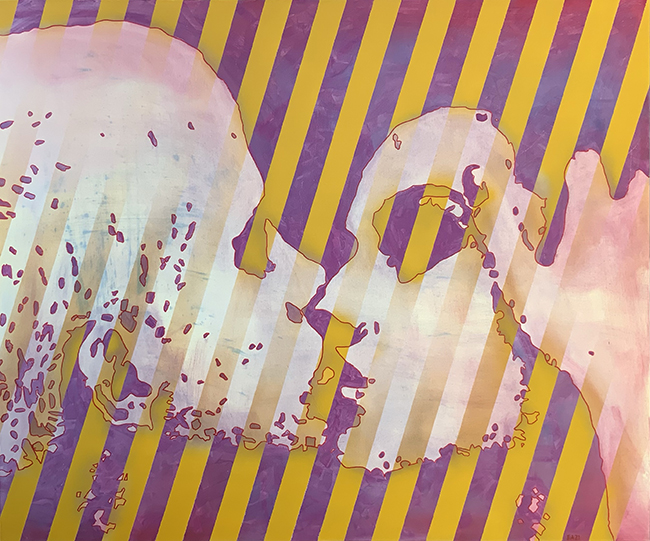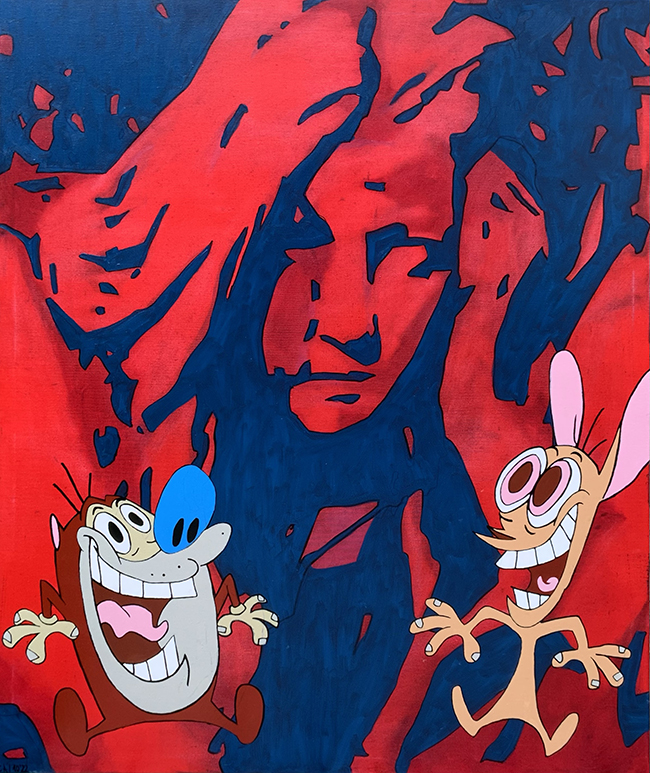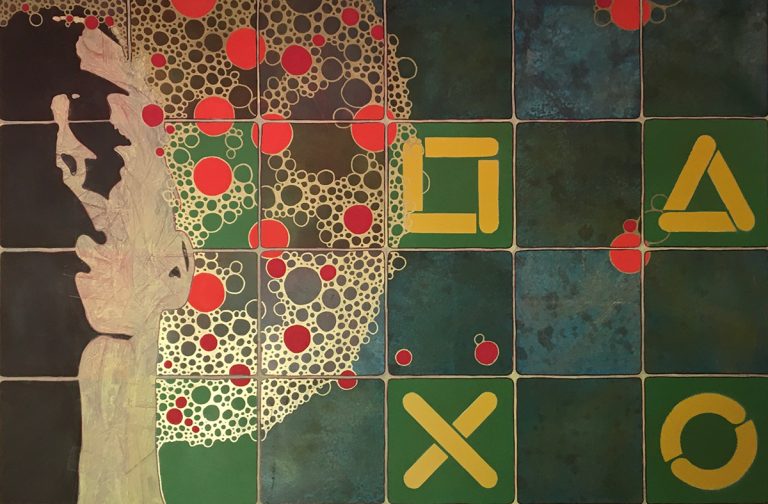In a world where efficiency often trumps beauty and growth overshadows aesthetics, Ettore Albert believes beauty isn’t just a luxury; it’s a necessity, a force capable of saving the world. With each stroke of his brush, Albert seeks to remind us of the transformative power of aesthetics, inviting us to envision a reality where freedom and joy reign supreme.
Albert’s artistic journey is steeped in the wisdom of Fyodor Dostoevsky, who once proclaimed that beauty will save the world. This belief permeates every aspect of Albert’s work, compelling him to challenge conventions and reimagine our priorities. Rather than adhering to the dictates of growth and efficiency, Albert advocates for a world where beauty takes precedence—a world where absolute freedom in creativity leads to unadulterated joy.

Gravity
Albert’s 2022 piece, Gravity, is a work that captures the viewer’s attention with its complex dialogue between abstracted forms and structured figures. The painting, which measures 100 by 120 cm and is executed in oil and acrylic, reveals a dissolution of forms typical of the avant-garde and post-impressionist movements. Rather than simply depicting objects, Albert suggests deeper emotional dimensions, inviting viewers to engage with the composition on a symbolic level.
In Gravity, forms merge and dissolve within one another. The faces and figures blend into geometric shapes, giving the sense of an absence—a purposeful vagueness that pushes the observer to feel rather than see. This intentional abstraction lets the viewer become a part of the image, with every glance adding a layer of interpretation. In Albert’s hands, the kiss is reduced, then elevated, to a suggestion rather than an explicit act, relying on a layered background that anchors the image with a harmonious mix of clean lines and balanced colors. Suspended in the foreground, the figures appear on the brink of movement, as if caught in a gravitational pull. The viewer is invited to complete the scene, to step in and make sense of the unresolved emotions embedded within the figures. Albert’s layered approach in Gravity is a testament to his belief in beauty as a transformative power—a medium that connects deeply with the viewer’s own inner experiences.

Mommy
Albert’s Mommy (2021), also a 100 by 120 cm piece in oil and acrylic, presents another intricate composition layered with different styles and textures. Here, geometric abstraction dominates the background, creating a grid that seems to incorporate, rather than merely frame, the objects within. The result is a painting where each element—every object and figure—feels integral to the composition. The background’s regimented squares form a grid that acts almost like a wall, inviting the viewer to explore the space within.
The most interesting part of the composition is a female face, positioned to one side and partially shadowed, creating an intriguing interplay between light and shadow. Albert uses light here as an external force—an invitation for the viewer to interact. It’s as if the viewer has illuminated the scene with a flashlight, focusing the eye on the face and features of the woman. This interaction enlivens the composition, lifting it from the confines of its geometric background. The contrast between the rigid structure of the backdrop and the expressive elements within reflects Albert’s skill for combining contrasting elements, building a dialogue between calm and tension, order and spontaneity. It’s a composition that invites the viewer to pause, examine, and find their place within the artwork’s rhythms.

Trinity
The 2022 painting Trinity is a statement on the blurred boundaries of today’s world, where distinctions—between reality and fiction, beauty and ugliness, right and wrong—are increasingly challenging to maintain. Albert captures this theme through an innovative mix of realism and abstraction. With a clear representational background that hints at realism, he brings in two fictional characters that disrupt this sense of order, creating a space where reality and imagination merge.
Albert’s choice of composition here is as intentional as his subjects. Rather than emphasizing the realism of the figures or the background, he blends both worlds, allowing them to coexist and even conflict. The characters in the foreground embody a departure from strict aesthetic conventions, acting instead as symbols of boundless imagination. This interplay justifies Albert’s intention to transcend fixed ideas of beauty, questioning why art must adhere to established norms. Trinity isn’t just a painting but a journey through the layers of reality, urging the viewer to see beyond what is visible and dive into the artist’s world—a world shaped by personal experience, fluid and open to interpretation.
Albert’s works—Gravity, Mommy, and Trinity—are united by their ability to pull the viewer into a meditative, introspective experience. In each painting, he uses layered techniques, light, and geometric structure to weave a complex narrative that allows for both reflection and interaction. His belief in beauty as a transformative force drives him to create pieces that challenge and provoke. Ettore Albert’s art does not offer simple beauty; it opens a door to an alternate reality, where aesthetics hold the potential to reshape perspectives, encouraging each observer to rediscover beauty as a force, not just a form.

